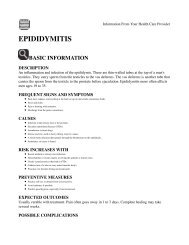Scarlet Fever.pdf
Scarlet Fever.pdf
Scarlet Fever.pdf
Create successful ePaper yourself
Turn your PDF publications into a flip-book with our unique Google optimized e-Paper software.
Information From Your Health Care Provider<br />
SCARLET FEVER<br />
BASIC INFORMATION<br />
DESCRIPTION<br />
<strong>Scarlet</strong> fever is a childhood (usually ages 2 to 10) skin rash disorder caused by a streptococcal (strep)<br />
bacteria infection. It is very contagious.<br />
FREQUENT SIGNS AND SYMPTOMS<br />
Symptoms may vary in different children. The following is the usual course of the disease:<br />
Day l<br />
<strong>Fever</strong> as high as 104°F (40°C); a red sore throat, swollen tonsils (tonsils may have a whitish coating),<br />
enlarged lymph glands in the neck, cough, vomiting.<br />
Day 2<br />
Bright red rash on the face, except around the mouth.<br />
Day 3<br />
Reddened tongue ("strawberry tongue") and rash in body creases, which spreads to the neck, chest,<br />
back, and then the entire body. The rash looks like a sunburn with bumps.<br />
Day 6<br />
The rash fades and skin may begin peeling, which can go on for 10 to 14 days.<br />
CAUSES<br />
Streptococcal or strep infection caused by a type of germ that produces a scarlet fever toxin (poison). Germs are spread by contact with an infected<br />
person, breathing in germs in the air, or touching an object with germs on it.<br />
Very few strep infections lead to scarlet fever. Not everyone is susceptible to the toxin that produces the rash. In a family, one child may get scarlet fever,<br />
a second may have only a strep throat, and a third may carry the germ and spread it to others, but not be sick.<br />
RISK INCREASES WITH<br />
Strep infections that recur often.<br />
Living in a place with many other people, such as a school dorm.<br />
Exposure to others in public places.<br />
Children ages 2 to 10.<br />
PREVENTIVE MEASURES<br />
Cannot be prevented completely, because some healthy persons will carry the strep germ without
eing ill. However, some ways to help prevent it include:<br />
Antibiotic treatment for at least 10 days for any strep infection.<br />
Avoid persons with sore throats.<br />
EXPECTED OUTCOMES<br />
With treatment, it is usually cured in about 10 days.<br />
POSSIBLE COMPLICATIONS<br />
Without treatment, infections that are more serious can occur.<br />
DIAGNOSIS & TREATMENT<br />
GENERAL MEASURES<br />
Your health care provider will do a physical exam. Tests may include throat culture or blood test for strep bacteria. Testing may done on other family<br />
members if they have symptoms.<br />
Care may be given at home.<br />
Treatment is done with a medication.<br />
Keep the ill person away from other people, including family members. After the patient has taken the medicine for 24 hours, they are no longer<br />
contagious and can return to school or childcare. The rash is not contagious.<br />
Use a cool-mist, ultrasonic humidifier to relieve the sore throat. Clean the humidifier daily.<br />
MEDICATIONS<br />
Antibiotics will be prescribed. Be sure to take all the doses even if the symptoms improve.<br />
Use acetaminophen for pain relief and fever. Do not give aspirin to children under age 18.<br />
ACTIVITY<br />
Extra rest is a good idea until symptoms improve.<br />
DIET<br />
No special diet. Do drink plenty of fluids.<br />
NOTIFY OUR OFFICE IF<br />
You or your child has symptoms of strep throat or scarlet fever.<br />
The following occur during treatment:<br />
<strong>Fever</strong> goes away and then returns.<br />
New symptoms begin, such as nausea; vomiting; earache; cough; headache; thick, colored nasal<br />
drainage; chest pain; or difficulty breathing.















